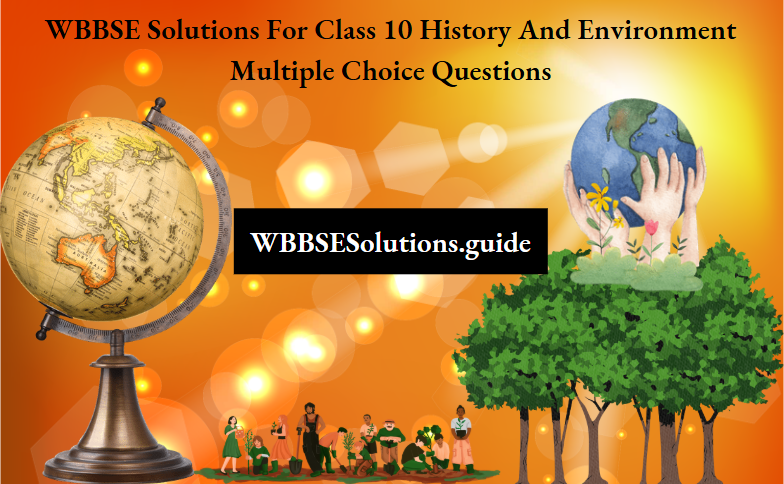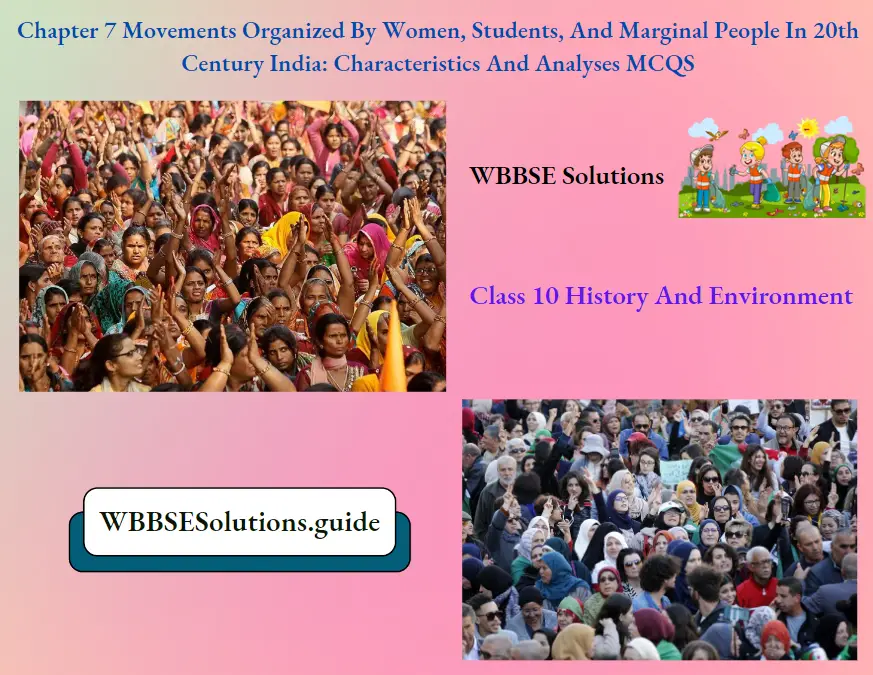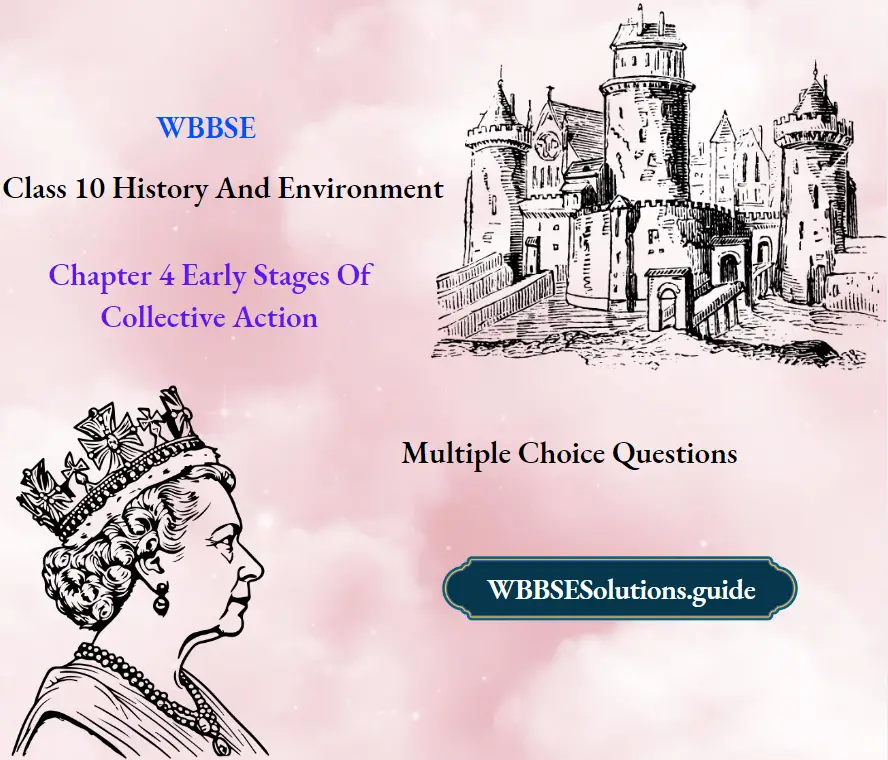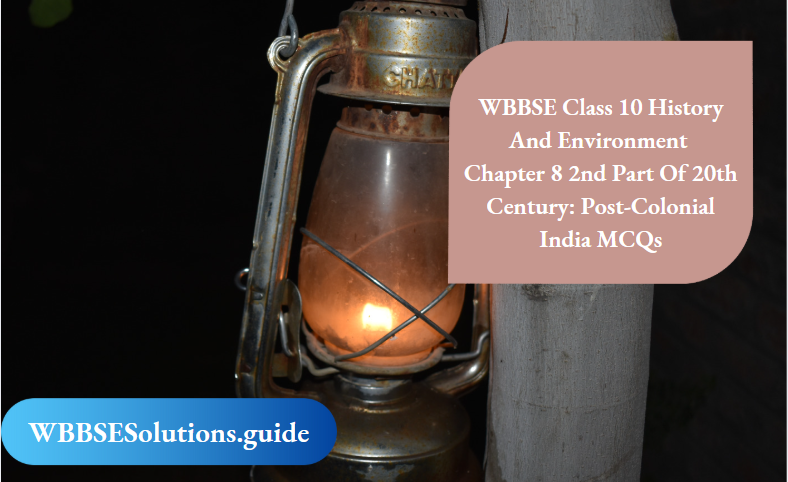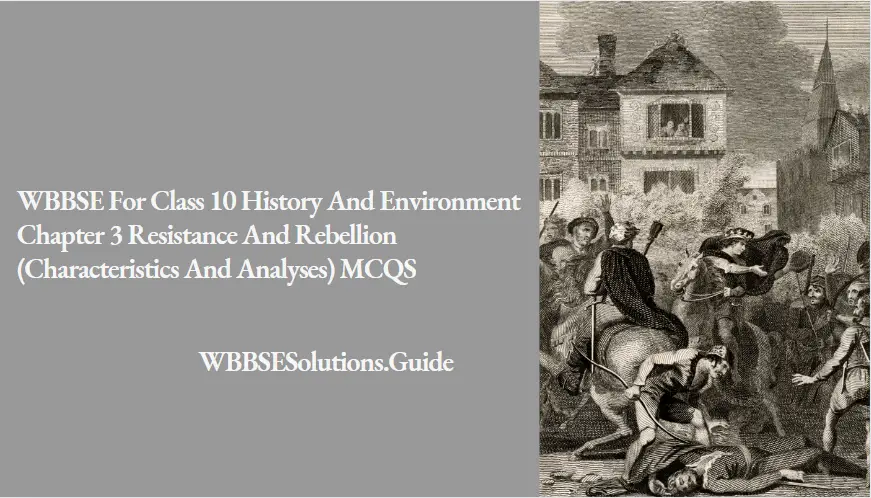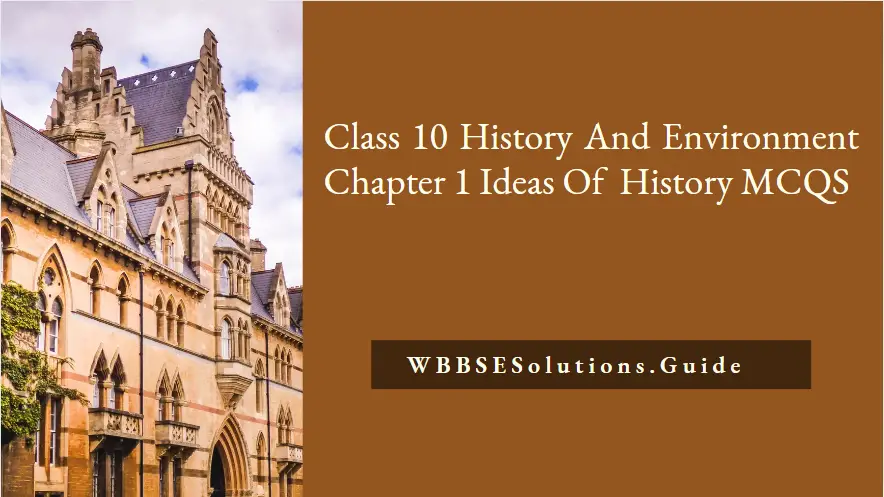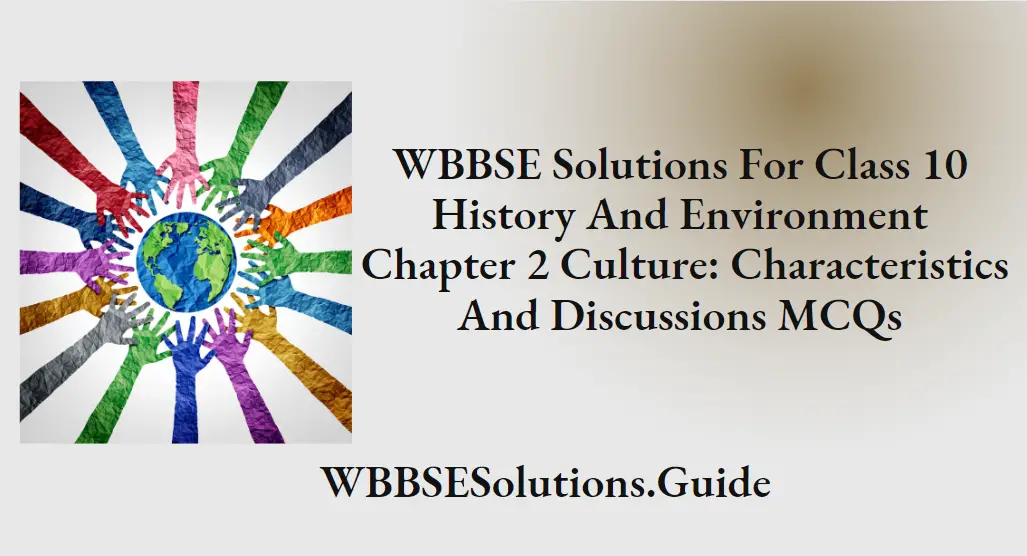Chapter 1 Ideas Of History Short Questions And Answers
Question 1. Write a note on the History of the Environment.
Answer:
History of Environment: The influence of the environment molds the thoughts and dealings in the lives of people
1. Influence on Poetry: The influence of the Lake District of England on the poetry of Wordsworth is widely acknowledged. In a similar vein, the studies in the poetry of Rabindranath Tagore reveal the influence of the landscape of the Gangetic Bengal (Silaidaha in present Bangladesh)
2. Degradation of Environment: However, because of global warming people all over the world are facing environmental hazards. There is no shred of doubt that India’s mountains, rivers, forests, and seas have gone a long way in shaping the lives, thinking, and mode of living of the people of India. Thus, inquiry into the history of the environment has become imperative
“WBBSE Class 10 History Chapter 1 SAQs, important questions, and answers”
3. Silent Spring: Silent Spring written by Rachel Carson (1962) is a well-documented book emphasizing the detrimental effects on the environment as a result of the indiscriminate use of pesticides. Carson, the author, accused the chemical industry of spreading disinformation and public officials of accepting industry claim
4. Work of Indian Environmentalists: Scholars such as Mahesh Rangarajan and Ramchandra Guha made environmental studies of considerable importance. Rangarajan’s books like ‘Hunting and Shooting’, ‘Facing the Forest’ and others have received the notice of the environmentalists. Ramchandra Guha, besides authoring his work on the history of sports, has his environment study, The Unique Wood. His other works in this line are This Fissured Land, Ecology and Equality, and others.
Read and learn all WBBSE Solutions For Class 10 History And Environment
Question 2. Describe Military History.
Answer:
Military History:
1. Subject Matter: The study of military equipment, military methods, military organization, development of weapons, change in military strategy, etc. is called Military history.
2. Now it has become a branch of history. The study of military history increased after the 1st World War and the importance of military history significantly increased after World War I.
In Defence of History:
- Richard J. Evans of Cambridge University mentioned in his book, “In Defense of History” that military history was indeed a part of traditional history.
- Through light on the history of defense, these writers dealt mainly with military history which includes the study of military methods. Various wars fought earlier and also novel history as a branch of history.
- Military history tells us how the people of a country defend their nation from enemies and how a nation is affected by war.
New Military History: The study of New Military history started in the 1970s and since then greater stress has been laid on
- Soldiers and generals
- The effect of war on society & culture.
Indian Military History:
- The Indian Military is the 3rd largest army in the world. We find the root of military history in India in the Vedic age where chariots, spears, swords, etc. were used in the battles.
- In modern times the East India Company started recruiting Indians in British Indian army men. The Indian army was known as the “Sepoy”.
- The British set up sepoys based on fulfilling their motive after the revolt of 1857. The British changed their policy.
- Thus, the study of military history as a branch of history is very important because even now wars are being fought in various parts of the world which affect the economy, society, and political conditions of a nation.
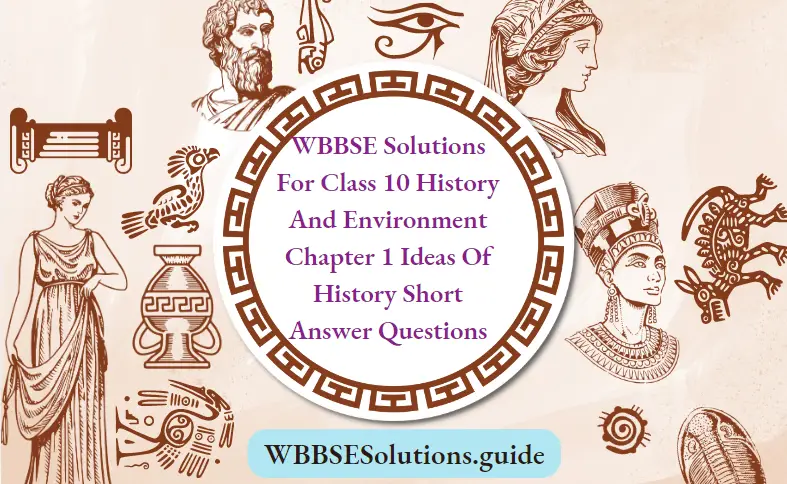
Question 3. State the use and abuse of the internet while collecting historical information.
Answer:
1. Use and Abuse of the Internet for Collection of History: In 1989 Tim Berners-Lee invented the Internet or World Wide Web (www.). Man has greatly benefited from the use of the Internet in every field from the study of science to trade and commerce all over the world.
In the present age of electronic media, we get much information about history from the internet. Without the help of any book, library, teacher, or researcher we can access all the information that we want from the internet.
There are various merits of using the internet. These are:
- No books are needed
- Information can be collected as and when required and
- The Internet helps us by providing the correct information about many complex problems.
The demerits of using the Internet are:
- The information collected may not always be correct
- Even today, everybody does not have access to the internet
- At times the required information may not be available and
- Nothing can be done if there is a link failure or if the server becomes inactive. Hence, it may be concluded that the internet, though a very useful tool, can never be a substitute for books.
Question 4. Discuss the importance of the thirty letters written by Jawaharlal Nehru to his daughter Indira.
Answer:
Letters from a Father to His Daughter:
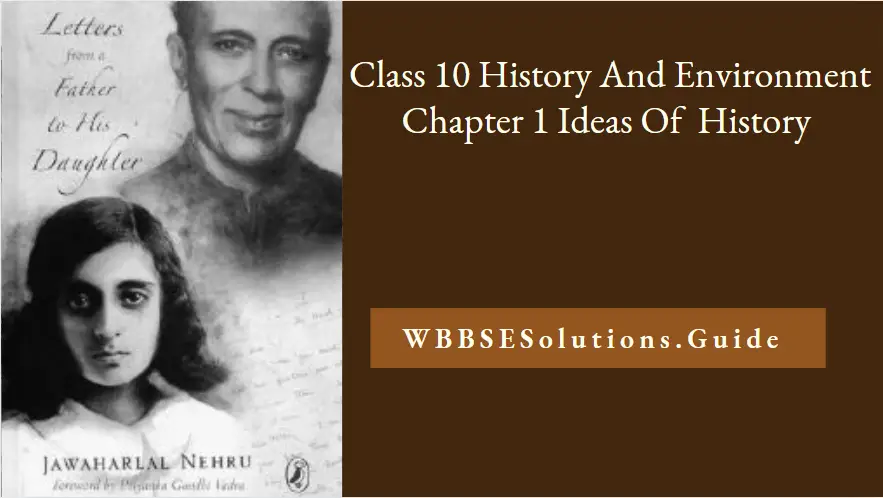
1. Introduction: Correspondences are an important source of information for the reconstruction of contemporary history. In this respect, reference may be made to the book entitled Letters from a Father to His Daughter.
This is a collection of 30 letters written by Jawaharlal Nehru, the first Prime Minister of India, to his daughter Priyadarshini, later Indira Gandhi. At that time Priyadarshini was only a 10-year-old girl,
2. Subject Matter: The letters communicated to Nehru’s daughter about things that a father should tell his daughter. The letters developed a standing bond between a father and his daughter.
The letters described how human beings slowly adjusted themselves to their surroundings. Nehru as a father also explained beautifully to his daughter, Priyadarshini, the major difference between man and other animals
3. Importance of the letters: The letters are, in fact, a storehouse of knowledge. Starting from the evolution of mankind Nehru communicated to his daughter about the essence behind the great Indian epics, the Ramayana and Mahabharata
“West Bengal Board Class 10 History Ideas of History short answer questions”
In very simple language, he explained to Indira complex things like race and religion that developed in India. Egyptian mummies, the beginning of communication, and various other topics have been discussed in the letters. The letters do not simply explain various facts but leave room for further studies to the readers.
Question 5. Describe the tenets of local history.
Answer:
Local History :
1. Chief Feature: The main objective of Local History is to ‘start history at your door’. To know more about local history and to collect information, schools can organize tours and a ‘History Society’. The specialty of this branch of history is to study and construct local history from practical materials. As a result, the students can associate freely with the subject
2. Importance of Space in Local History: Social scientists have adopted space or territory as the basis for constructing history. Modern researcher Dr. David Luden wrote the book ‘Early Capitalism and Local History in South India as an important step in the study of local history. In recent times, space has been given greater importance while writing history. Space is closely linked to local history, microhistory, and the history of different families
3. Relation with other Fields: Local history is also associated with traditions, economics, and sociology. Local history is also linked with globalization, though it is to a very small degree.
4. Locality and Region: It should be noted that there is a difference between locality and region. A region includes a locality, but a locality does not include a region.
The relationship between the two can be shown like this (from bottom to top): local → sub-regional → national → international. This history is constructed based on local matters
5. Evolution of Local History: In ‘St. Paul’s Western Side’ a conference called ‘A Flood of History’ was organized for the first time. The local people, teachers, students, and historians collected a good deal of information for the study of History.
1. In the West Side Conference of America, local history has been called Community Empowerment through Neighbourhood History. Local Development and awareness are the key issues of this History.
2. The lifestyle of people, culture, psychology, the past and present of urban life all while constructing the local History. In the 1960’s decade, local history was defined like this: it is the history of a new village, the history of a new city, the history of a new locality, and also the story of the locality’s families, men, women, and children.
3. History should be re-written for every generation and the source material should be none other than the local history. The specialty of this branch of History is to collect information by traveling in a region and analyzing various events and incidents that had taken place in that area
6. Indian Examples: ‘Nadiya Kahini’ of Kumud Nath Mallick, ‘Murshidabad Kahini’ of Nikhilnath Ray, ‘History of Jessore and Khulna’ of Satishchandra Mitra, ‘History of Coochbehar’ of Amanatullah Ahmed, ‘A History of Jaipur’ of Dr. Jadunath Sarkar, etc. are some of the directions of the study of local History.
Question 6. Discuss the urban history.
Answer:
Urban History :
1. Factors in Urbanisation: If we analyze the history of cities, we come to know that the cities started developing and extending after the Industrial Revolution.
The three main factors in the growth of cities are the emergence of economies, the colonization of vast areas, and the growth of democratic ideas. In the process of urbanization, this method is equally applicable to all the countries of the world
2. Urbanisation in the Nineteenth Century: While discussing urbanization in the nineteenth century, the names of two cities are worth mentioning. The first one is London in England, which, in the nineteenth century, was the largest city in the world. The second one is Bombay in India
3. Industrial Revolution and Urbanisation: Before the Industrial Revolution in the 1850’s decade, most of the western countries had rural-based economies.
During the initial period of the Industrial Revolution, there were only two industrial towns in England, viz. Leeds and Manchester. In 1851, of the total population of Manchester, three fourth consisted of people who had migrated from rural areas
4. Growth of Urbanisation in India: In colonized India, cities in the three Presidencies of Bombay, Madras, and Calcutta developed to a great height. Historian Stephen Tharnstorm of Havard University made a special effort the study Urban History in 1970.
It encouraged Radharaman Mitra, Radha Prasad Gupta, Purnendu Patri, Nikhil Sarkar, etc. to study the history of Kolkata.
Bombay was declared the capital city of the Presidency of Bombay in 1819. It was called a ‘city of dreams’. In the nineteenth century, the main cities of the Indian sub-continent were ‘Business City’; Jaipur is called the ‘Pink City’, and Calcutta is called ‘the City of Culture’
5. Conclusion: Hence, the subject matter of Urban History is to study the origin and evolution of cities. The new branch of urban history has been expressed by Dr. S.N. Mukherjee, Rina Oldenberg, Pradip Singh, Dr. Narayani Gupta, and Dr. Aniruddha Ray.
They thought that the study of urban history was neglected. Therefore, Dr. Ashis Bose said ‘In India, urban history is non-existent!
Question 7. What did people wear in ancient India?
Answer:
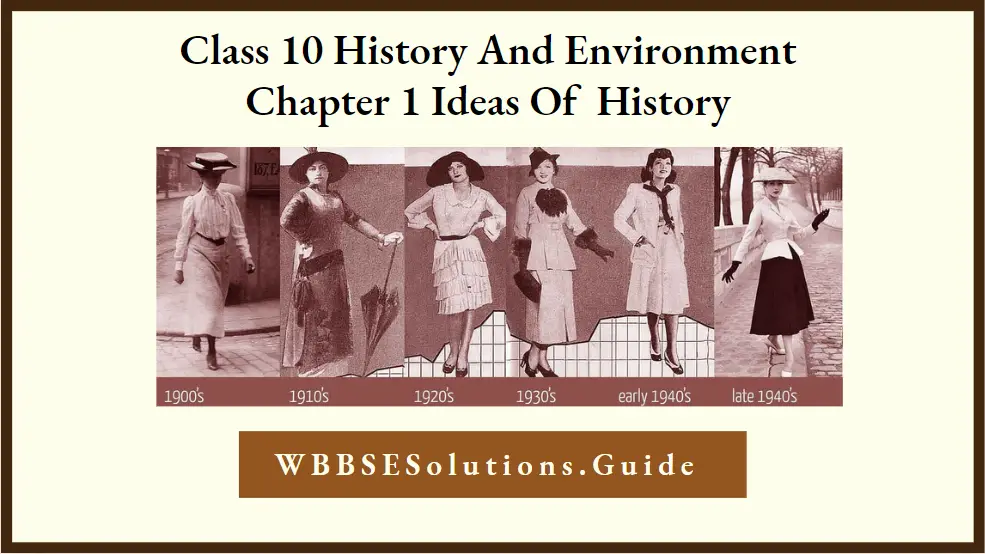
Ancient Indian Clothing:
1. Cotton Clothing: People in India wore mostly cotton clothing. India was the first place where people grew cotton, even as early as 2500 BC in the Harappan period.
2. Women’s Clothing: By the Vedic period, women wore one very long piece of cloth called a sari that they wrapped around themselves in different ways.
The word “sari” comes from a Sanskrit word that just means cloth. Saris are first mentioned in the Vedas, about 600 BC. Rich women wore saris made of silk from China, but most women wore cotton saris.
3. Ways of Wearing Garments by Women: There were many different ways of wrapping saris to dress up women wore them like skirts with atop parts thrown over their shoulders or worn over their heads as a veil.
Working women often pulled their sari up between their legs to make a sort of pants. Women who were fighting with the army tucked in the top part of the sari in the back, to free up their arms for fighting.
“Class 10 WBBSE History Chapter 1 SAQs, exam preparation guide”
Most saris were five or six yards long, although some saris were nine yards long too. Younger women generally wore brightly colored saris, but widows and other women in mourning for someone who had died wore only white saris.
4. Men’s Clothing: Men also wore one long piece of cloth called the dhoti, which was generally white. They wrapped the dhoti (DOE-tee) around their legs to make sort of pants like the working women. Dhotis though were shorter so they didn’t have the part that covered the chest and shoulders. Men also often wore long cotton cloths wrapped around their heads as turbans.
5. Clothing after Muslim invasions: With the Islamic invasions around 1000 AD, Persian fashions in clothing entered India and became popular, especially in the north, though they never replaced the sari or the dhoti.
Both women and men began to sometimes wear trousers with long tunics over them down to their knees. The trousers are called churidar or salwar kameez. Women generally wore churidar with a long veil or scarf over it.
Question 8. Describe the Golden Age of Indian cinema.
Answer:
Golden Age of Indian Cinema :
1. Introduction: Following India’s independence,- the period from the late 1944s to the 1960s is regarded by film historians as the ‘Golden Age’ of Indian cinema. Some of the most critically acclaimed Indian films of all time were produced during this period.
2. Parallel Cinema Movement: This period saw the emergence of a new parallel cinema movement, mainly led by Bengali cinema. Early examples of films in this movement include Chetan Anand’s Neecha Nagar (1946), RitwikGhatak’s Nagarik (1952), and Bimal Roy’s Do Bigha Zameen (1953), laying the foundations for Indian neo-realism and the “Indian New Wave”.
Pather Panchali (1955), the first part of The Apu Trilogy (1955-1959) by Satyajit Ray, marked his entry into Indian cinema. The Apu Trilogy won major prizes at all the major international film festivals and led to the ‘Parallel Cinema’ movement being firmly established in Indian cinema.
Its influence on world cinema can also be felt in the “youthful coming-of-age dramas that have flooded art houses since the mid-fifties” which “owe a tremendous debt to the Apu trilogy”.
3. Contribution of Bengali Directors: The cinematographer Subrata Mitra, who made his debut with Satyajit Ray’s The Apu Trilogy, also had an important influence on cinematography across the world.
Satyajit Ray and Ritwik Ghatak went on to direct many more critically acclaimed ‘art films’, and they were followed by other acclaimed Indian independent filmmakers such as Mrinal Sen, Mani Kaul, Adoor Gopalakrishnan, G. Aravindan, Girish Kasaravalli, and Buddhadeb Dasgupta.
4. Commercial Hindi Cinema: Commercial Hindi cinema also began thriving; examples of acclaimed films at the time include the Guru Dutt films Pyaasa (1957) and Kaagaz Ke Phool (1959) and the Raj Kapoor films Awaara (1951) and Shree 420 (1955).
These films expressed social themes mainly dealing with working-class urban life in India.
5. International Awards: Sivaji Ganesan became India’s first ever actor to receive an international award when he won the “Best Actor” award at the Afro-Asian film festival in I960 and was awarded the title of Chevalier in the Legion of Honour by the French Government in 1995.
Tamil cinema is also influenced by Dravidian politics, with prominent film personalities like C N Annadurai, M G Ramachandran, M Karunanidhi, and Jayalalithaa becoming Chief Ministers of Tamil Nadu.
Several Indian films from this era are often included among the greatest films of all time in various critics’ and directors’ polls.
Question 9. Discuss the history of paintings in Bengal.
Answer:
History of Bengali Art :
1. Introduction: The Bengal School of Art, commonly referred to as Bengal School, was an influential art movement and a style of Indian painting that originated in Bengal, primarily Kolkata and Shantiniketan, and flourished throughout India during the British Raj in the early 20th century
2. Element of Nationalism: Also known as the ‘Indian style of painting’ in its early days, it was associated with Indian nationalism (swadeshi) and led by Abanindranath Tagore (1871-1951) but was also promoted and supported by British arts administrators like E. B. Havell,.
The principal of the Government College of Art, Kolkata from 1896; eventually it led to the development of modern Indian painting.
3. Revolutionist Movement: The Bengal school arose as an avant-garde and nationalist movement reacting against the academic art styles previously promoted in India, both by Indian artists such as Raja Ravi Varma and in British art schools
4. Contribution of Havell: Following the influence of Indian spiritual ideas in the West, the British art teacher Ernest Binfield Havell attempted to reform the teaching methods at the Calcutta School of Art by encouraging students to imitate Mughal miniatures. Havell was supported by the artist Abanindranath Tagore, a nephew of the poet Rabindranath Tagore
5. Contribution of Abanindranath Tagore: Tagore painted several works influenced by Mughal art, a style that he and Havell believed to be expressive of India’s distinct spiritual qualities, as opposed to the “materialism” of the West.
Tagore’s best-known painting, Bharat Mata (Mother India), depicted a young woman, portrayed with four arms in the manner of Hindu deities, holding objects symbolic of India’s national aspirations. Tagore later attempted to develop links with Japanese artists as part of an aspiration to construct a pan-Asianist model of art.
6. Conclusion: The Bengal school’s influence in India declined with the spread of modernist ideas in the 1920s. As of 2012, there has been a surge in interest in the Bengal School of Art among scholars and connoisseurs.
Question 10. Discuss the history of sports in India before and after independence.
Answer:
Before independence :
1. Sports During the Vedic Period: The history of sports in India dates back to the Vedic era. Physical culture in ancient India was fuelled by religious rights. The mantra in the Atharvaveda, says, “Duty is in my right hand and the fruits of victory in my left.” In terms of an ideal, these words hold the same sentiments as the traditional Olympic Oath: “For the Honour of my Country and the Glory of Sport.”
2. Badminton: Badminton probably originated in India as a grown up’s version of a very old children’s game known in England as Battledore and Shuttlecock, the battledore being a paddle and the shuttlecock a small feathered cork, now usually called a “bird.”
3. Indoor Games: Games like chess (chaturanga), snakes and ladders, and playing cards, originated in India, and it was from here that these games were transmitted to foreign countries, where they were further modernized.
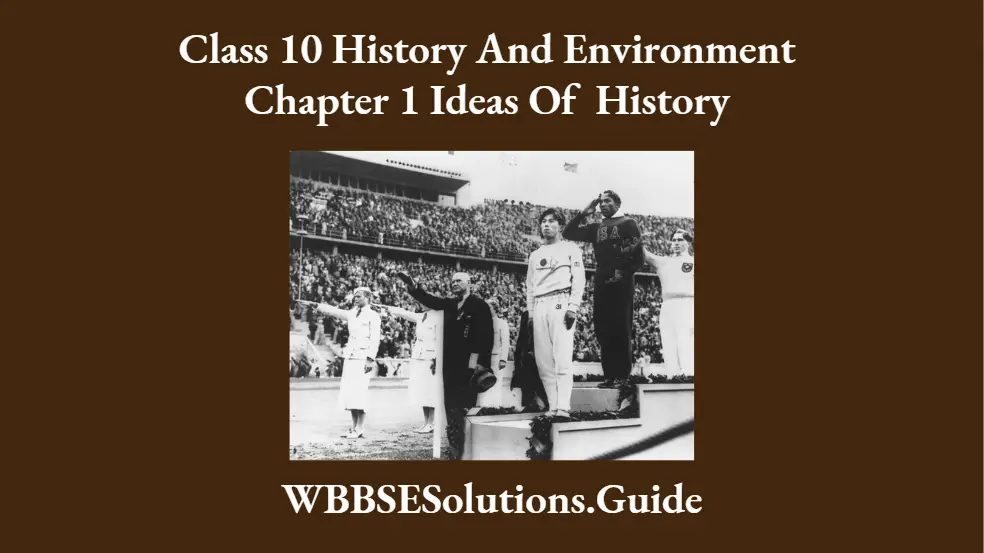
After independence:
1. Asian Games: India hosted the Asian Games in New Delhi in 1951 and 1982. The Ministry of Youth Affairs and Sports was initially set up as the Department of Sports in 1982 at the time of the organization of the IX Asian Games in New Delhi. Its name was changed to the Department of Youth Affairs & Sports during the celebration of the International Youth Year in 1985.
2. Other Sports Events Hosted by India: India has also hosted or co-hosted several international sporting events, including the 1951 and the 1982 Asian Games, the 1987 and 1996 Cricket World Cups, the 2003 Afro- Asian Games, the 2010 Hockey World Cup, and the 2010 Commonwealth Games. Major international sporting events annually held in India include the Chennai Open, Mumbai Marathon, Delhi Half Marathon, and the Indian Masters. The country co-hosted the 1987,1996, and 2011 Cricket World Cups and the first Indian Grand Prix in 2011.
3. Conclusion: The history of sports in India is very ancient and dates back to the Vedic era. It is more likely that many of today’s Olympic disciplines are advanced versions of games of strength and speed that flourished in ancient India. Chess, wrestling, polo, archery, and hockey (possibly a fallout from polo) are some of the games believed to have originated in India.
Question 11. Give an account of the history of different modes of transportation in India.
Answer:
Walking: In ancient times, even with a decent road system, there was no means of transportation, and people covered (PNG distances on foot or bullock carts. For instance, Adi Sankaracharya traveled all over India from Kalady near Kochi. Walking still constitutes an important mode of transport in urban areas. In the city of Mumbai, to further improve the transit conditions for pedestrians, the Mumbai Metropolitan Region Development Authority has commenced the construction of more than 50 skywalks as part of the Mumbai Skywalk project.
Palanquin: Palanquins, also known as palkis, were one of the luxurious methods used by the rich and noblemen for traveling. This was primarily used in the past to carry a deity or idol of a God, and many temples have sculptures of God being carried in a palki. Later on, it was primarily used by European noblemen and ladies from the upper classes of society before the advent of the railways in India. Modern use of the palanquin is limited to Indian weddings and pilgrimages.
Bullock cart and horse carriage: Bullock carts have been traditionally used for transport, especially in rural India. The arrival of the British saw improvements in the horse carriages which had been used for transport since the early days. Today they are used in smaller towns and are referred to as Tonga or buggies. Victorias of Mumbai are still used for tourist purposes, but horse carriages are now rarely found in the metro cities of India. In recent years large cities have banned the movement of bullock cans and other slow-moving vehicles on the main roads.
Bicycles: Bicycles or cycles have ownership rates ranging from around 30% to 70% at the state level. Along with walking, cycling accounts for 50% to 75% of the commuter trips for those in the informal sector in urban areas. However, recent developments suggest that bicycle riding is fast becoming popular in the metro cities of India. Today, government development authorities all over India encourage the setup and use of separate bicycle lanes alongside the roads to combat pollution and ease traffic congestion.
Hand-pulled rickshaw: Hand-pulled rickshaw is still available in the city of Kolkata wherein a person pulls the rickshaw by hand. The Government of West Bengal proposed a ban on these rickshaws in 2005 describing them as “inhuman”. Though a bill aiming to address this issue, termed as ‘Calcutta Hackney Carriage Bill’, was passed by the West Bengal Assembly in 2006, it has not been implemented yet. The Government of West Bengal is working on an amendment to this bill to avoid the loopholes that were exposed when the Hand-pulled Rickshaw Owner’s Association filed a petition against the bill.
Question 12. Write the importance of photographs in modern Indian history.
Answer:
Importance of Photographs in Modern Indian History :
1. During the Reign of the East India Company: In the early years of the English East India Company photographers came to India from Britain. They were mostly employees of the company. Some were amateur photographers and others were employed to take photographs
2. Use of Photography in Archaeology: The East India Company’s officials deliberately encouraged photography, particularly to record the archeological sites. Photography became indispensable in identifying important archeological evidence
3. Messers Bourne and Shepherd: In India, the earliest photographic institution was Messers Bourne and Shepherd of Calcutta. It opened its studio in 1864.
4. Importance of Photography: Photography helped the process of acculturation (adopting customs from another civilization) in Bengali society. This is illustrated in the two novels of Rabindranath Tagore, namely Chokher Bali and Yogayog. In the former, the hero Mahendra indulged in taking photographs of the inmates of the house as a matter of hobby.
5. Role of the Revolt of 1857: The Great Indian Mutiny of 1857 attracted photographers like Dr. John Murray, Felix Beato, and the husband-wife team of the Tytlers. Their photo collection was a photographic record of history which up to then had consisted of only text and sketches/paintings of war scenes. This was followed by the European photographers exploring the bewildering variety of peoples, cultures, and monuments of the Indian subcontinent in albums for commercial sale and presentation back home.
6. Conclusion: This is what helps in distinguishing a photograph from just being a method of capturing a moment to being a piece of artwork, a reflection of the subject’s mood, clothing, character, and image. The presence of subjectivity and viewer interest helps in making a photograph more meaningful than just a record as it takes the viewer beyond just what is seen and gives it a deeper meaning. The historical 19th-century pictures by European photographers presented a vision of India that matched the perception of the British as an exotic pageant of the East’s ancient monuments, tribal natives, rich princely rulers, and strange traditions.
Question 13. What kind of historical information do we get from Somprakash?
Answer:
Somprakash :
1. Contribution of Dwarakanath: Somprakash, a weekly newspaper, was started on 15 November 1858, (1 Agrahayan 1265 BS) by Dwarakanath Vidyabhusan. Dwarakanath (1819-1886) was a professor at Sanskrit College in Calcutta. The original plan was mooted by Iswar Chandra Vidyasagar (1820-1891), who continued to advise Dwarakanath in editorial matters. From April 1862, Somprakash was published from Dwarakanath’s house at Changripota village, near Sonarpur, south-east of Calcutta. Due to other preoccupations, Dwarakanath relieved himself of editorial duties on 2 January 1865. Mohanlal Vidyavagish took over and even Shibnath Shastri took charge for a few months. Dwarakanath resumed as an editor on 27 July 1874. After the Vernacular Press Act (March 1878), Somprakash roused resistance against the Government, and publication was suspended for a year. After providing written assurance of allegiance to the Government, it reappeared on 19 April 1880. After Dwarakanath’s death, the publication was handed over to a trust, which continued it for a few more years.
2. Role in Political Awakening: Somprakash was the first Bangla newspaper to indulge in political discussions. Social and political issues are regularly featured in it. Dwarakanath shunned ‘groupism’ and never threw invectives at anybody as was done by the other newspapers of the day. Omprakash did not support all policies of the Government; it raised its voice against the Vernacular Press Act and in support of the Ilbert Bill. It opposed child marriage and kulinism. Though not clearly in favor of women’s freedom, it supported women’s education and widow remarriage. Omprakash looked down upon Keshab Chandra Sen and the Brahma Samaj. It protested against indigo and tea planters. Its attitude to the landholders was somewhat moderate. Vidyabhusana Library at Changripota has some volumes of Omprakash.
Question 14. Discuss the importance of the study of the history of music and dance.
Answer:
The importance of the study of the history of music and dance
Discussion on the historiography of performing arts like music, dance, drama, and cinema relates to the culture or cultures performing these and the thought process they express.
Music :
1. Introduction: Rob Wegman in his article, On Historical Musicology, argued that historical inquiry is fundamentally creative and expressive of ‘who we are’. Thus writing of history creates community identity and makes it vitally important to adopt an appropriate method for writing history including music history
2. Ancient History: Music has been an integral part of India’s culture. Natyasastram of Bharata Muni, a sage of Tamil Nadu (400 BC), written in Sanskrit has classified musical instruments into five systems. However, the oldest preserved example of Indian music is to be found in the Samaveda of the Vedic corpus. The melodies of the Samaveda, commonly known as Sama-gan (Sama-songs), are still sung in certain Vedic sacrifices. They are the earliest accounts of Indian musical hymns. The Samaveda and other Hindu texts influenced Indian classical musical tradition
3. Recent History: Presently there are two distinct styles, Carnatic and Hindusthani. Traditional Bengali music, it may be said that the earliest music in Bengal was influenced by the Vaishnava poetry, Gitagovinda by Jayadeva during the thirteenth century. During the nineteenth century, Bengali ballad songs, collectively known as Panchali gan, created history.
Dance:
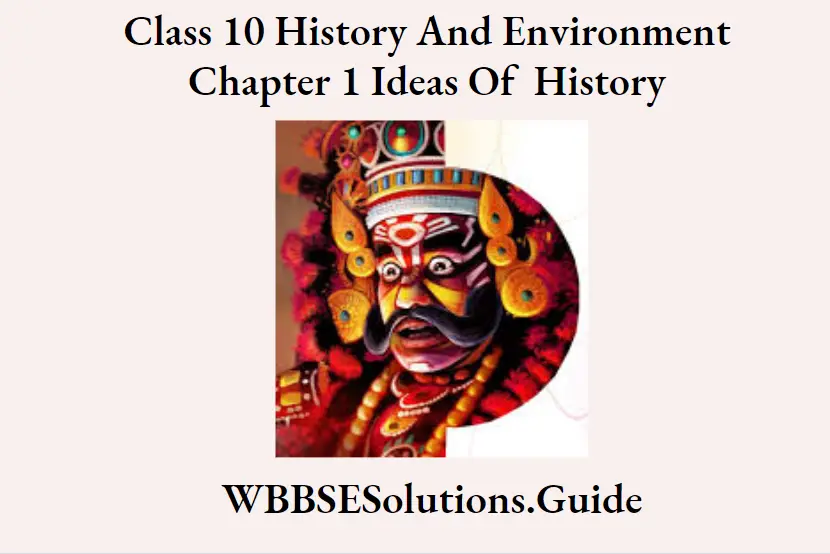
1. The Historiography of Dance: The historiography of dance exposes the important connections between identity politics and the creation of classical dance. This may be illustrated by the example of the Kuchipudi dance of the Andhra region. Through an in-depth study, it has been found that classicism (adherence to classical principles) in Kuchipudi dance creates and supports the hegemonic version of the Telegu history
“Ideas of History WBBSE Class 10, solved short answer questions”
2. Ancient Texts on Dance: Natyasashtra and Abhinaya Darpana are the two most important ancient Sanskrit works on Indian classical dance. The modern interpretation of classical Ind in dance, Bharatnatyam, is based on the treatise Natyasastra. The monumental treatise on music, Sangitaratnakara includes a chapter on the traditions of dance. The practice also deals with the topic of how dance developed in different parts of the country. The author of the treatise, Sharangadeva, pointed out that the Natyasastra tradition was usually followed in different regions, but some deviations and changes were well accepted. The author also introduced some new concepts like style and movements in dance. Sharangadeva, while recognizing the classical form of dance, also at the same time spoke of a regional variant under the name desipaddatis.
3. Bengali Dance: Coming to Bengal, it may be said that the Bengali dance forms have drawn heavily from folk traditions. Particularly the tribal folk dances as also the broader Indian dance traditions have influenced the Bengali dance. Chhau Nritya, Gaudiya Nritya, etc. are special dance forms of Bengal. Besides, the dances set on the songs of Tagore and Nazrul Islam are also very popular.
Question 15. Explain the factors that determine the food habits of people.
Answer:
The factors that determine the food habits of people are
The most important feature related to human life is the food habits of people. So attention is now paid to people’s food habits in the study of new social history.
1. Climatic factors: The food habits of the people of different regions vary according to the difference in climate. For example, the Food habits of warm climates are different from the food habits of cool climates.
2. Geographical factors: Geographical factors of an area are also responsible for determining the food habits of the people.
3. Availability of food: The easy availability of food items in different regions is also responsible for determining food habits. For example, in Bengal, owing to the presence of rivers, fish is one of the important items of food.
4. Inventions: Different types of inventions like the invention of fire have also changed the food habits of the people of ancient times.
5. Religious Beliefs: Food patterns are influenced by religious beliefs. The food people eat is also dictated by their religious beliefs at times.
Question 16. What do you understand by the term ‘history’? What were the topics of historical discussion in the previous century?
Answer:
History
The term ‘history’ refers to the ‘tales of the past’. So history includes the study of the society, politics, economics, and religion of the prehistoric as well as the historic ages. Earlier the study of history was confined to the elite classes of society and the most significant social, political, and religious events. These included
1. Stories of royalty: In earlier times one of the most important topics of discussion was the rise and fall of various dynasties, wars, conquests, successes and failures of brave generals and heroes, and so on.
2. Story of the aristocracy: In the last century matters concerning the lifestyle of the nobles, aristocrats, local lords, landlords, and ruling classes constituted the main subject of discussion.
3. Religion: In the earlier century one of the main topics of discussion was the different religious activities of the people.
4. Political events: The various significant political events of the past found a place in the historiography of earlier times. Imperialism, colonialism, and the spread of Western ideas easily became the topics of discussion.
5. Disasters: The various disasters of the past including floods, droughts, earthquakes, epidemics, and massive loss of lives also came up for historical discussions.
Question 17. Which aspects of the common people have found an important place in contemporary historical discussion?
Answer:
In the previous century, the chief topics of historical discussion included various events concerning the royal family, the elite, feudal lords, and landlords. However, in recent times, the various aspects concerning the common people have found a place in the discussions of history. Such as:
1. Man’s urge to live: The struggle of the common people to live in the background of wars and political events is now an important subject of discussion.
2. Life of the common folk: Along with the various events concerning the upper classes, the events concerning the lower classes are also being discussed. The role of the common people in the state, society, religion, politics, economy, etc. has become increasingly important.
3. Art and culture: Nowadays, the cultivation of art and culture by the common people is also being simultaneously discussed with the tales of wars fought by kings and princes. An increasing interest in society, sports, dress, food habits, visual arts, painting, etc. of the common classes is being noticed.
4. Struggle of common people: History also deals with the transformation of the state and society which is the result of the struggle of the common people.
5. Evolution: The various developments in science, technology, religion, etc., have been possible due to the efforts of the common people for ages. These topics have also found a significant place in history.
Question 18. Discuss the ramifications of historical discussions in recent times. Or, Mention the diverse aspects of historical discussions in modern times.
Answer:
The ramifications of historical discussions in recent times
Earlier the discussion of history included only the tales of royal families, the rise and fall of dynasties, the exploits of heroes and generals, the lifestyle of the upper classes, and so on. However, recently the study of history has become more interesting and diversified due to the inclusion of several new topics. These are as follows:
1. Activities of the monarchy: History continues to discuss wars, conquests, the establishment of peace, treaties, the rise and fall of dynasties, etc.
2. Discussion about the elite class: The discussion about the aristocrats, landlords, feudal lords, etc. still constitutes an important part of historical discussion.
3. Discussion about the common people: Though the lifestyle, food habits, dress, art and culture, sports, environment, etc. of the common people were neglected in earlier times, nowadays, these aspects of common life have found much importance.
4. Local and regional history: Nowadays much importance is being given to the study of local and regional history. So the people of all continents, countries, cities, and villages have now been included in the purview of history.
5. History of science: The study of history also includes the continuous development of science, technology, and medical science since ancient times.
Question 19. What do you mean by ‘new social history’? From which point of view is this subject discussed?
Answer:
New social history
Social history forms a significant part of historical discussion. Previously, social history was confined to the discussion about the royal families, the aristocrats, and the upper classes but now the scope of the discussion has expanded, and discussions about the people belonging to the middle, lower, and marginal classes have assumed much importance. Therefore, social history is now termed as ‘new social history’. New social history had its beginning in 1960-70. At this time, history began to be discussed from the point of view of the lower classes.
1. View from bottom to top: In new social history, an attempt is being made to view things from bottom to top instead of the other way around. This means that society is now viewed more widely based on the role of the lower classes rather than from the viewpoint of the upper classes.
2. Predominance of the larger community: New social history assigns more importance to the wider, common, or lower and marginal classes rather than to the handful of aristocrats. The contribution of the larger community to society and culture is more emphasized.
Question 20. Whose discussion finds a place of eminence in new social history? Who has popularised the new social history in modern times?
Answer:
The discussion of the larger community consisting of the lower, poor, marginal, and ordinary people has found a place of eminence in the discussion of new social history in the 20th century. New social history originated in 1960-1970. Since then, different historians have made their contributions to popularise this subject. They are as follows:
1. Importance of annual group: Marc Bloch and Lucien Febvre published a journal named ‘Annals of Economic and Social History’ in 1921. This French Annal group played an important role in popularising the study of new social history. Fernand Braudel and Laduree have illuminated on statistics, family, psychology, society, culture, and economy of the common people.
2. Role of American historians: Eugene Genovese and Herbert Gutman discussed the lifestyle of the laborers, the system of slavery, and slave society. There is also proof of such discussion in the journal ‘Past and Present’.
3. Subaltern studies: This involves the study of lower classes. It has become popular in India and other South Asian countries since the 1980s. Historians like Ranajit Guha, Partha Chattopadhyay, Gyanendra Pandey, Shahid Amin, Sumit Sarkar, Dipesh Chakrabarty, Gautam Bhadra, and others have elaborately discussed the lower class society irrespective of caste and religion.
Question 21. Which topics have become significant in the recent study of the cultivation of art? What is the significance of music in the study of the cultivation of art?
Answer:
We can form an idea about the cultural progress of a community from the study of its cultivation of art. The different branches of art include music, dance, drama, and cinema. Man has been cultivating different types of art since time immemorial. Music forms an important branch of art and the study of the history of music is gradually being popularised.
1. Cultivation of music by aristocrats: In ancient times the cultivation of music in the royal courts was chiefly associated with the upper classes and the common people were almost detached from it. So, a clear idea can be formed about the caste distinction in a society from the study of the cultivation of music.
2. Influence of Outsiders: The history of music helps us to understand whether the music of a particular community was influenced by that of some other society or community, and if so, then what was the extent of such influence. The influence of music also indicates the cultural prosperity of a society or community.
3. Evolution of Indian music: In the earlier ages Indian society was dominated by devotional music but later on due to continuous evolution, massive changes came about in Indian music in the 20th century. In this course of evolution, Rabindrasangeet, Nazrulgeet, etc. became popular in Bengal.
“WBBSE Class 10 History Chapter 1 notes, SAQs, and explanations”
4. Diversity: Different types of music filled the treasure house of music of the different communities as a result of continuous evolution and transformation. Nowadays, along with devotional music, folk songs, Rabindrasangeet, Nazrulgeet as well as film songs, band music, etc. have harmoniously lent diversity to the storehouse of Bengali music.
5. Study of the history of music: Recently, researchers and experts have engaged in a detailed study of the history of the music of different countries. Umesh Joshi, Raj Jumar, KarunamoyGoswami, Sudhir Chakrabarty, Mridulkanti Chakrabarty, and others have greatly contributed to the field of the history of Indian music.
Question 22. How has the historical study of drama become important in the modern age as a part of visual arts?
Answer:
The cultivation of drama has its origin in the civilizations of ancient times. The ancient Greek dramas still impress the audience in different countries.
1. Expansion of drama in Europe: Though dramatic performances were prevalent in ancient Europe, cultivation of dramatic art in the modern sense began in the 16th-17th centuries and became popular in the 18th~19th centuries. The plays written by Shakespeare, Christopher Marlow, Ben Jonson, John Galsworthy, Bernard Shaw, etc. attained immense popularity.
2. Expansion of drama in Bengal: Modern dramatic art developed in Bengal in the 18th-19th century. This art which began in the 18th century developed profusely in the 19th century and is continuing. Names of some significant contributors are Michael Madhusudan Dutta, Dinabandhu Mitra, Girish Chandra Ghosh, Rabindranath Tagore, Dwijendralal Roy, Sisir Bhaduri, Sambhu Mitra, Utpal Dutta, and others.
3. Reflection of society: The plays belonging to different countries and societies reflect contemporary events, oppression, tyranny, social discrimination, imperialism, nationalism, etc. This drama can become a mirror to society and also act as a social media.
4. History of drama: In recent times, researchers have seriously engaged in the study of the history of drama. Some important works are ‘Bangiya Natyashalar Itihas’ by Brajendranath Bandhopadhyay, ‘Drishya Kavya Parichay’ by Satyajiban Mukhopadhyay, ‘Bangle Natya Sahityer Itihas’ by Asutosh Bhattacharya, ‘Madhyajuger Bangla Natya’ by Selim Al Deen, ‘Bangladesher Lok Natak: Bishoy 0 Angik Boichitro’ by Simon Zakaria, ‘National Theatre for India’ by Baldoon Dhingra, etc.
Question 23. Discuss the study of the history of architecture in the modern age.
Answer:
History of architecture in the modern age:
The art of architecture originated at the time when ancient cavemen learned to build houses. The art of architecture forms a significant component in the study of history.
1. Architectural construction: In the past, it was the kings and wealthy people who showed interest in building structures. In the modern age, apart from the ruling class, common people are also associated with various architectural constructions.
2. Studying the history of architecture: The backdrop, style, and patronage of various forms of architecture have become important subjects for historical discussions. Recently, the architecture of Europe, India, and Bengal has found a prominent place in the study of history.
3. Origin of the historical study of architecture: The study of the history of architecture began in India in the 19th and 20th centuries. Some of the pioneers in this field were Alexander Cunningham, Percy Brown, J. Fergusson, Catherine Asher, etc.
4. Studying the history of architecture in Bengal: Different researchers have studied the development of the art of architecture in Bengal at different ages. Notable ones among them are George Michell, Amiya Kumar Bandhopadhyay, Shamsunnahar Lovely, Dr. Nazimuddin Ahmed, etc.
WBBSE Chapter 1 Ideas Of History Fill In The Blanks
Question 1. The autobiography of Sarala Debi Chaudhurani is called ______
Answer: Jibaner Jharapata.
Question 2. The first women’s cricket club was established in England in _____
Answer: 1887.
Question 3. After Michael Faraday discovered____________ controlled flow of electricity with the help of signals became very convenient.
Answer: Electro Magnetic Induction.
Question 4. The term eco-feminism was first used by the French feminist____ in 1970.
Answer: Francois Doban.
Question 5. Rabindranath in his book_____has told many stories from his childhood.
Answer: Jiban Smriti.
Question 6. The word Historia is a ____ word.
Answer: Greek.
Question 7. Kumud Nath Mallik is a _____
Answer: Local Historian.
Question 8. Tuzuk-I-Babari is the autobiography of ______
Answer: Babur.
“WBBSE Class 10 History Chapter 1 important SAQs, for board exams”
Question 9. The leader of the Nazi regiment was _____
Answer: Adolf Hitler.
Question 10. Rabindranath Tagore published his popular novel ____ in Banga Darshan.
Answer: Chokher Bali.
Question 11. Radha Rani’s novel was published in Banga Darshan in ______
Answer: 1875 A.D.
Question 12. The editing office of Banga Darshan was ________
Answer: Majumdar Agency.
Question 13. Sannyasi Revolt is discussed in _____ novel.
Answer: Anandamath.
Question 14. The National Song Vande Mataram is mentioned in the _______novel.
Answer: Anandamath.
Question 15.’Letters from a Father to his Daughter’ was written in ___ A.D.
Answer: 1928.
Question 16. The writer of the book Jiban Smriti is ______
Answer: Rabindranath Tagore.
WBBSE Chapter 1 Ideas Of History True Or False
Question 1. New Social History is a study of kings and their empires.
Answer: False
Question 2. The song ‘Vande Mataram’ was composed by Rabindranath Tagore.
Answer: False
Question 3. The first Bengali periodical to be published was ‘Digdarshan’.
Answer: True
Question 4.’Bangadarshan’ was a journal edited by Bankim Chandra Chattopadhyay.
Answer: True
Question 5. From the decade of 1970, the history of sports gained popularity at the endeavor of the British.
Answer: True
Question 6. The meaning of the term ‘history/ is to search.
Answer: True
“Best SAQs for WBBSE Class 10 History Chapter 1 Ideas of History”
Question 7. The time limitation of Old Social History seems to be 1960 A.D.
Answer: True
Question 8. There was development in the art of history writing by the effect of the Renaissance.
Answer: True
Question 9. The history of sports is as old on this earth as the existence of men on this earth.
Answer: True
Question 10. New Social History discusses only the nation and the social structure and development of individuals.
Answer: True
Question 11. The Olympic Games were first organized in Egypt.
Answer: False
Question 12. Agriculture was discovered in the Mesolithic age.
Answer: False
Question 13. Colonialism affected the food habits of people in India.
Answer: True
Question 14. Vidya Bhushan was the founder of Bangadarshan.
Answer: False
